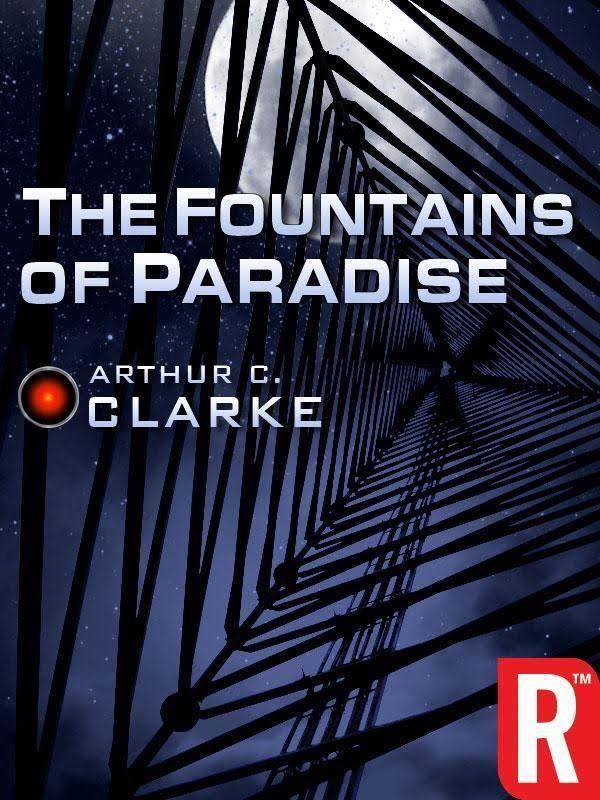8 /10 1 Votes8
Cover artist Terry Oakes Language English Originally published 1979 Page count 256 | 4/5 Goodreads Publication date 1979 Genre Science Fiction | |||||||||||||||||||||||||||||||||
 | ||||||||||||||||||||||||||||||||||
Similar Arthur C Clarke books, Hugo Award for Best Novel winners, Science Fiction books | ||||||||||||||||||||||||||||||||||
The fountains of paradise by arthur c clarke book review
The Fountains of Paradise is a novel by British writer Arthur C. Clarke. Set in the 22nd century, it describes the construction of a space elevator. This "orbital tower" is a giant structure rising from the ground and linking with a satellite in geostationary orbit at the height of approximately 36,000 kilometers (approx. 22,300 miles). Such a structure would be used to raise payloads to orbit without having to use rockets, making it much more cost effective. The novel won both the Hugo and Nebula Awards for Best Novel.
Contents
- The fountains of paradise by arthur c clarke book review
- Plot summary
- Major characters
- Themes
- Setting
- Similarities with other works of Clarke
- Awards and nominations
- References
Plot summary
In the 22nd century, Dr Vannevar Morgan is a famous structural engineer who hopes to develop the "space elevator" from a theoretical concept to reality and enlists the resources of his employers to carry out experiments. But the only suitable starting point (Earth station) for the elevator lies at the summit of a mountain in Taprobane occupied by an ancient order of Buddhist monks, who implacably oppose the plan.
Morgan is approached by a Mars-based consortium to develop the elevator on Mars as part of a massive terraforming project. To demonstrate the viability of the technology, Morgan tries to run a thin cable of "hyperfilament" from an orbital factory down to ground level at Taprobane. A monk at the monastery, a former astrophysicist who is a mathematical genius, tries to sabotage the attempt by creating an artificial hurricane using a hijacked weather-control satellite. His attempt succeeds, but the hurricane blows butterflies to the peak of the mountain. This fulfills an ancient prophecy that causes the monks to leave the mountain. The tower can be built on Earth after all.
Forced to resign his position for acting beyond his authority, Morgan joins the Martian consortium named "Astroengineering" and construction of the Tower commences.
Several years later, the Earth-based tower is well under construction and travel up and down—both for tourists and for transfer to rocket ships—is being trialled.
An astrophysicist and a group of his students and tower staff are stranded in an emergency chamber six hundred kilometres up after an accident with their transport capsule. They have limited food and air supplies. Whilst a laser on a weather-control satellite is able to supply heat, it is imperative to provide them with filter masks against the increasing carbon dioxide and also with food, air, and medical supplies.
Despite his rapidly failing health, Morgan asserts his right to travel up the tower in a one-man "spider" to rescue them. He nearly fails, with limited battery power, but ultimately succeeds in reaching the chamber, delivering the supplies, and thus saving the stranded scientists. Morgan walks around outside the tower to investigate damage the accident caused.
On the way back down, he realizes that the geostationary satellites could be connected, and more space elevators could be constructed, forming a wheel-like structure without gravitational perturbation problems. Then he has a heart attack and dies.
A short epilogue envisages Earth many centuries later, after the sun has cooled and Earth has been depopulated, with humans now living on the terraformed inner planets. Several space elevators lead to a giant "circumterran" space station that encircles Earth at geostationary altitude. The analogy with a wheel is evident: the space station itself is the wheel rim, Earth is the axle, and the six equidistant space elevators the spokes.
Major characters
Themes
The main theme of the novel is preceded, and to some extent juxtaposed with, the story of the life and death of King Kashyapa I of Sri Lanka (fictionalised as King Kalidasa). It foreshadows the exploits of Vannevar Morgan in his determination to realise the space elevator.
Other subplots include human colonization of the solar system and the first contact with extraterrestrial intelligence.
Clarke envisions a microscopically thin but strong "hyperfilament" that makes the elevator possible. Although the hyperfilament is constructed from "continuous pseudo-one-dimensional diamond crystal", Clarke later expressed his belief that another type of carbon, Buckminsterfullerene, would play the role of hyperfilament in a real space elevator. The latest developments in carbon nanotube technology bring the orbital elevator closer to possible realisation.
Setting
The story is set in the fictional equatorial island country of Taprobane, which Clarke has described as "about ninety percent congruent with the island of Ceylon (now Sri Lanka)", south of its real world location. The ruins of the palace at Yakkagala as described in the book very closely match the real-life ruins at Sigiriya in Sri Lanka. The mountain on which the space elevator is built is called Sri Kanda in the book, and bears a strong resemblance to the real mountain Sri Pada.
